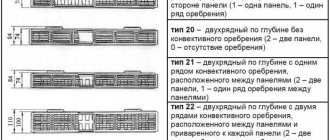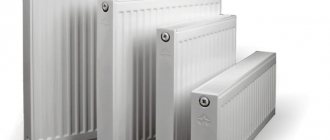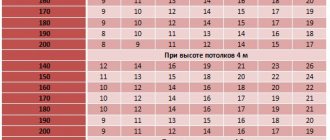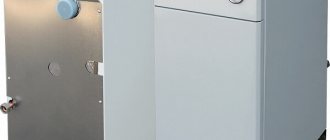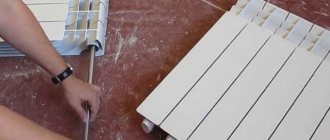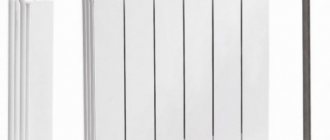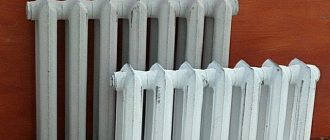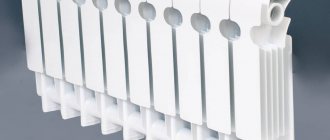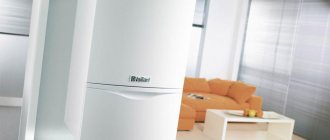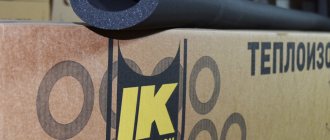Advantages and disadvantages of Prado radiators
These radiators are quite popular, the reason for which is their quite obvious operational advantages:
Installed radiator
- The weight of Prado radiators is small, so their transportation and installation is not particularly difficult. The included mounting brackets are also very convenient - just study the diagram or watch the video to hang the battery correctly.
- The heat transfer of these devices is very efficient, the panels heat up quite quickly. True, they cool down just as quickly.
- The appearance of the radiators is quite presentable (you can judge it from the photo in this article), and thanks to the use of high-quality paint, the panels retain their whiteness for a long time.
- The cost of these devices is quite affordable, which is explained by their domestic origin.
- Also, as a plus, Prado radiators can show good pressure testing performance in terms of temperature and pressure. And the warranty on Prado brand products is another significant advantage.
The Prado has few disadvantages, but still, they exist and must be taken into account:
- The rapid cooling of radiators has already been mentioned here.
- Inability to accurately regulate temperature even on models with a built-in thermostat.
- Problems with the varnish coating on some models.
https://youtube.com/watch?v=nnQz2VA7C_M
Of course, many modern radiator models do not even have these shortcomings, but if we take the price-quality ratio, then, perhaps, Prado will be one of the leaders.
All of the above can be summarized quite simply: Prado heating radiators are high-quality devices with good performance. So if you are not concerned about the nuances of operation of these radiators indicated in this article, feel free to choose Prado!
Prado radiators for home heating
´Igor
4 years ago
Hello. Three years ago, my family and I decided to move from an apartment to a private house. They did not build the house themselves, but hired a construction company. She installed Prado steel panel radiators in the house. We have been using radiators for three years now. We lived through three winters. I really like a lot, but there are also minor disadvantages, but I will write about them below. The area of the house is larger than the area of the apartment, and the size of the radiators is not large. At first, I thought that the radiators would not be able to heat such an area, or that the boiler would work at maximum all year. But my fears did not come true. Despite the thinness of the radiators, the house was always warm in winter, and the boiler worked at half power all the time. From which I concluded that Prado brand radiators have high heat transfer. I am very pleased with how the radiators perform their function and have no complaints. The radiators were assembled to perfection. All parts are firmly connected to each other. The assembly was done diligently. There are no sharp edges or irregularities on the surface of the radiator. The quality of the radiators is excellent. But now we come to the cons. They're not that scary. In my opinion. The appearance is very ordinary, nothing special. Everything is done in a fairly stencil manner and is familiar to panel radiators. This is just my opinion, but I didn't see anything special in the design. But design excesses are more of a nice addition to radiators than a necessary feature. Their main task is to heat, and Prado radiators cope with it remarkably well. They fit quite well into the decor of the room. The radiators are painted white, which is not noticeable. But it is worth noting that, despite the rather banal color of the radiators, the paintwork was done to a fairly high quality. In the end, I’m happy with the appearance, although I could have come up with something more interesting, but again, this is not the main thing, I didn’t buy it to look. Maybe for some, appearance has significant weight when choosing radiators. Cleaning radiators is not difficult; just a simple vacuum cleaner is enough. Therefore, there are no special difficulties with cleaning. With regular cleaning, the radiator will never turn into a dust collector and will not lose its operating efficiency. In conclusion I would like to say. I'm happy with the radiators. The radiators are assembled with high quality and provide excellent heating, but many will not take into account shortcomings regarding the banal appearance. Their affordability and price-quality ratio are of great importance to me. Especially lately this has played a big role. And also the fact that they are produced in Russia partially persuaded me to choose these radiators. Would I recommend these radiators to friends and family and ordinary, ordinary buyers? Certainly!
Answer
Steel heating radiators Prado and their features
Despite the fact that there is a huge range of heating devices on the domestic market, Prado steel heating radiators are extremely popular among consumers. These heating devices are made of high quality steel and have many other advantages.
In this article we will try to understand in detail why these radiators are attractive.
About company
The company engaged in the manufacture of the radiators under consideration has a fairly rich history, since it was founded in the city of Izhevsk back in 1959. NITI "Progress" at that time was one of the favorites of engineering and technical thought of the USSR. After the collapse of the USSR, the company underwent restructuring and repurposing.
I would like to emphasize that the production of steel heating radiators at the production facilities of NITI “Progress” was mastered recently - in 2005. It was then that the Prado trademark appeared. In parallel with this, a trading house was opened in Izhevsk, the main task of which was to promote Prado radiators on the domestic market.
Today, heating batteries produced under this brand have gained popularity not only in the Russian Federation, but also in other former Soviet republics. Moreover, the products of the Prado trading house were awarded cups at industry exhibitions many times and were awarded diplomas.
Advantages
The popularity of Prado radiators is associated with their following advantages:
- The structure is lightweight, making it easy to install it yourself. Moreover, the mounting brackets are very ergonomic; the only thing is to familiarize yourself with the mounting diagram before installing the battery.
- Effective heat transfer and high heating rate.
- Panel batteries look attractive, and thanks to the use of high-quality paint, they remain white for a long time.
- Models with multiple panels provide air convection, which increases heating efficiency.
- The price is quite affordable.
- Durability if the operating rules are followed.
Flaws
The disadvantages of Prado radiators are associated with the design features; therefore, they are characteristic of all panel radiators.
In particular, the following points can be highlighted:
- The devices are not intended for use in centralized heating systems, since they cannot withstand high pressure and water hammer, and also require clean coolant.
- The coolant temperature should not be more than 120 degrees Celsius.
- The operating instructions for the devices do not recommend draining water from the system, as this can lead to corrosion in the panels.
- It is also impossible to correctly adjust the heating temperature in models equipped with a thermostat.
- Problems with the varnish have been reported on some models.
Note! The high pressure for which these heating devices are calculated is 0.9 MPa. Destruction occurs at a pressure of 2.25 MPa
It goes without saying that many models of modern radiators do not have the disadvantages listed above, but if we compare the price/quality ratio, Prado radiators obviously win. The only thing is that before purchasing you need to make sure that the characteristics of the heating system match those of the radiators.
Conclusion
Prado panel steel radiators are a good choice for autonomous heating systems whose pressure does not exceed 0.9 MPa. Although they are cheap, they attract with their quality and beautiful appearance.
In addition, the wide range of these products allows you to select the optimal power of the devices in each individual case. From the video in this article it is possible to glean additional information on this topic.
Strengths and weaknesses of batteries
Tubular models of heating devices are appropriate for use in private homes, where the heating system is characterized by a stable and low operating pressure in the absence of sudden surges and water hammer.
The popularity of tubular devices is due to a set of their positive qualities:
- high working pressure and ability to withstand water hammer;
- resistance to mechanical damage due to the absence of gaskets in welded sections;
- uniform heating of the surface and high heat transfer;
- smooth surface prevents dust accumulation;
- ease of installation , possibility of bottom and side connections, various placement options;
- possibility of temperature adjustment when equipped with a thermostatic valve.
In addition to fasteners, tubular radiators can be equipped with special brackets used as heated towel rails.
There is also a whole category of models classified as design radiators - they are used to create an interior. These devices can be produced in the form of frames for mirrors or railings for stairs. Floor-to-ceiling height models are successfully used for zoning a room.
By giving intricate shapes to heating devices, manufacturers increase the competitive attractiveness of their products. But in steel batteries shaped like railings, the functional load increases
A lot of positive qualities and excellent characteristics inherent in steel heating radiators make their use attractive. Such devices are easy to fit into the interior; they allow you to visually expand the space.
However, we should not forget about the disadvantages of tubular models, which are as follows:
- low resistance to corrosion processes, especially evident when the quality of the coolant is low; Spot welding areas are most susceptible to corrosion.
- high cost.
As for cost, tubular batteries are by no means a budget solution. Their installation is most often resorted to by designers who are not constrained by funds when implementing their projects.
Pros and cons of panel radiators
Panel-type batteries, like any equipment, have their strengths and weaknesses. Their main advantage over their counterparts made from other materials is cost and appearance. These advantages are especially noticeable when compared with copper or cast iron models.
We recommend: Installing heated electric floors
The advantages of panel structures are as follows:
- Reliability and simplicity of the device . The absence of complex elements minimizes the likelihood of breakdown.
- Easy to install . It is possible to carry out installation work on your own. Both bottom connection to the circuit and side connection are also available.
- Good heat transfer , which is achieved not only by the large battery area, but also by convection.
- Economical . Panel models of devices require a minimum amount of coolant, which requires less energy to heat up. Savings, in comparison with equipment made of cast iron, can reach 30-40%.
- Presentable appearance - this allows you not to spend additional money on the purchase and installation of decorative and protective screens.
- Wide assortment - a rich model range with various dimensions in length, depth, height of devices.
It is obvious that panel instruments have quite a lot of advantages, which explains their popularity and demand. But they also have significant disadvantages. If this is neglected, the stable and reliable operation of the entire heating system can be jeopardized.
The weaknesses of panel-type equipment are as follows:
- Sensitivity of welds to water hammer . With centralized heating, safe operation is only possible if a gearbox is installed, the purpose of which is to mitigate water hammer.
- Tendency to corrosion , which manifests itself especially acutely when the quality of the circulating fluid is low. The cyclical six-month absence of water inherent in central heating systems significantly accelerates corrosion, reducing the service life of the radiator.
- The likelihood of defects - during transportation and operation, the instrument panels are easily scratched, which can also accelerate corrosion.
When choosing panel-type steel radiators, you need to take into account all the details of their operation, especially when connecting to central heating systems.
Technical characteristics and scope of application
Prado radiators are made of steel alloys, and they are susceptible to corrosive processes, so they can only be used when installing closed-type heating systems. In this case, they will last quite a long time.
If you plan to replace the heating system in an apartment building, first of all, you need to contact the operating organization to clarify its parameters. The choice of the type of heating units for the apartment depends on the state in which it is located.
Multi-storey buildings are currently supplied with heat according to different schemes. If the house is connected in accordance with an independent option or there is an individual water treatment system, then batteries can be installed from any metal, including steel alloy.
If the heating system is dependent, this means that the building is connected directly, then the quality and composition of the coolant should be clarified.
Prado radiators made of steel alloys can be used in heating structures that have certain parameters:
- water temperature no more than 120 degrees;
- with a material thickness of 1.2 millimeters, the working pressure should be 0.9 MPa, and with 1.4 millimeters - 1.0 MPa;
- the required crimping pressure when using steel with a thickness of 1.2 millimeters is 1.25 MPa, and when using steel with a thickness of 1.2 millimeters - 1.5 MPa;
- the required tensile pressure if the sheet thickness is 1.2 millimeters is 2.25 MPa, and 1.4 millimeters is 2.5 MPa;
- for a working environment, hydrogen activity should be in the range from 8 to 9.5, but it is better if 8.3 - 9.
The amount of various impurities in the coolant is of no small importance. If there are filters and mud traps on the riser, then usually their number is small. In case of direct connection to the central heating supply line, you should not purchase panel radiators made of steel alloys
In the case of direct connection to the central heating supply line, you should not purchase panel radiators made of steel alloys.
The reason is that vertically located manifolds for moving the working medium have such a narrow cross-section that the presence of a significant amount of suspended particles leads to them becoming clogged. Since Prado radiators are a non-separable structure, it will be difficult to do anything if the coolant circulation is disrupted.
Comparison criteria for steel radiators
The main criterion of all times and peoples is the efficiency/price ratio. In this case, the ratio of power to cost.
Types of steel panel radiators
For radiators, another criterion is also important: the power-to-weight ratio.
To determine which steel heating radiators are better, reliability is important, especially in Russian conditions. Let's present this indicator through two criteria:
- pressure that the radiator can withstand
- maximum coolant temperature
Good with a steel radiator, bad without a steel radiator!
“Theory is dry, but the tree of life is ever green,” as old Goethe used to say. Therefore, when determining the rating of heaters, we will also take into account reviews of the products of one or another manufacturer of steel radiators and information about the technical innovations they have used.
When calculating the rating, we will compare panel radiators of type “22” (with two heating panels and two convectors) of the most popular dimensions - 500x500 mm.
About company
The company engaged in the manufacture of the radiators under consideration has a fairly rich history, since it was founded in the city of Izhevsk back in 1959. NITI "Progress" at that time was one of the favorites of engineering and technical thought of the USSR. After the collapse of the USSR, the company underwent restructuring and repurposing.
I would like to emphasize that the production of steel heating radiators at the production facilities of NITI “Progress” was mastered recently - in 2005. It was then that the Prado trademark appeared. In parallel with this, a trading house was opened in Izhevsk, the main task of which was to promote Prado radiators on the domestic market.
Today, heating batteries produced under this brand have gained popularity not only in the Russian Federation, but also in other former Soviet republics. Moreover, the products of the Prado trading house were awarded cups at industry exhibitions many times and were awarded diplomas.
Application
Since steel is used to produce Prado batteries, these products are susceptible to corrosion processes. This circumstance allows them to be connected only to closed heating systems in which steel radiators demonstrate their efficiency, reliability and durability.
When equipping heating networks in multi-storey residential buildings with Prado batteries, you should definitely contact the organizations providing operational services to clarify the parameters of these networks. It must be borne in mind that steel models can be safely installed in networks operating according to an independent scheme, as well as in the presence of an autonomous water treatment system. If the house is connected to external sources, it is necessary to clarify the properties of the coolant.
Specifications:
- height – 300 and 500 mm;
- width – 400-3000 mm;
- depth – 72-174 mm;
- coolant temperature – no more than +120° C;
- pressure (working) – 0.9-1.0 MPa;
- crimping (test) pressure – 1.25-1.5 MPa;
- coolant hydrogen activity coefficient (Ph) – 8-9.5.
SELECTION OF THE REQUIRED PANEL RADIATOR, CALCULATION BY ROOM AREA
A panel radiator is an efficient heating unit and, due to its large heated area, has increased heat transfer. Panel radiators have a wide range of sizes, both vertically, from 300 to 900 mm, and horizontally, from 400 to 3000 mm.
Depending on the size and type of panel radiator, its heat transfer rate also changes, that is, the amount of heat emitted by the radiator per unit of time, which is measured in Watts (W). Each radiator, in addition to the type and dimensions markings, has its own main indicator - thermal power.
There are averaged simple formulas for calculating the required total thermal power for space heating.
The first method is based on a calculation of 100 W per 1 m² of room. For example, if the room is 15 m² then 100 x 15 = 1,500 W. Accordingly, we need a radiator with a power of at least 1,500 W; for example, a panel radiator 500x800, type 22 with a power of 1,515 W is suitable.
But there are many external factors and variables that affect the amount of heat energy needed to maintain a comfortable room temperature.
The influencing factors are obvious: ceiling height, number of windows, the presence of an external door in the room, thermal insulation of the house - floors, walls and ceilings, connection method and location of heating radiators. But no less important factors will be the wind rose, the upper and lower temperature thresholds during the heated season, even the orientation of the walls to the cardinal points.
In reality, it is difficult to take into account all these factors to accurately calculate the required thermal power, and for household calculations some rules have been adopted:
– presence of a window in the room + 100 W;
– presence of an external door + 200;
– the total influence of all unaccounted factors + 20% to the resulting amount of required thermal power.
In the second formula, we will proceed from a calculation of 40 W per 1 m³ and taking into account the above rules.
For example, a room 3 by 6 meters and a ceiling height of 3.2 meters, two windows, one 900 mm wide, the second 1200 mm wide, and an external door:
(3 x 6 x 3.2 x 40 + (100 x 2) + 200) + 20% = 3,245 W
In total, 3,245 W of radiator thermal energy is required to heat our room.
3,245 / 2 windows and we get an average thermal power per radiator equal to 1,622 W
Of course, you can install one Airfel 500×900, type 22 radiator with a thermal power of 1704 under each window in the room, but to achieve the maximum effect, it is necessary to take into account the size of the window openings.
Regarding the installation of the radiators themselves, you must follow some rules. For example, if there are windows in the room, as in the second sign, radiators must be installed on the wall under the windows so that the convection flow of heated air creates a heat shield. Also, the radiator must be equal to at least 80% of the width of the window opening.
And now, using the table of heat output and taking into account the number of windows in the room and their opening width, we will select a panel radiator that meets our requirements:
The best panel steel radiators
Now let's move on to the rating of steel radiators, which has collected popular product series based on customer reviews and product characteristics. Let's start with panel radiators, which are affordable and light in weight.
Kermi FKO 22 radiator series
This series of radiators is ergonomic and affordable. The design easily fits into any interior.
Characteristics of the model range
Panel radiators of this series are made of structural steel. The length of the models varies from 400 to 3000 mm, and the height is 300-900 mm. The depth of the radiators is standard and is always 100 mm. The heating radiator is designed to transfer coolant with a temperature of 110 degrees.
All products in the range can withstand pressure of 10 bar. Therm x2 technology was used in their production, increasing heat transfer. The power of the radiator depends on the dimensions of the specific model. For example, 900x600 mm produces 1898 W.
Design features:
- The design of the steel radiator is strictly rectangular with sharp edges;
- to start convection, there is ample perforation on the top panel;
- the front side with relief makes them more interesting;
- two-way side connection;
- center distance 250/500/850 mm;
- wall mount included;
- The approximate coolant capacity is 5 liters per 0.5 m² of radiator area.
Radiator series Kermi FKV 22
Another series of radiators from the German brand Kermi, with more “blown” shapes. It stands out for its increased reliability and long service life. Radiators are available in a wide range of colors including pink, red, blue, green and orange.
Characteristics of the model range
The series of panel radiators is available with a height of 500 mm and a width from 400 to 1500 mm. The smallest panel, 400x500, weighs 12 kg and is capable of delivering 772 W of power. Crimping pressure is 13 atm, working pressure is 10 atm. The maximum permitted coolant temperature is 110 degrees. Plain water or a glycol mixture can be used as a coolant.
Design features:
- bottom connection;
- thickness of the metal sheet of the front panel - 1.25 mm;
- possible location of the valve both on the right and on the left;
- ½ thread for connection to heating pipes.
Buderus Logatrend VK-Profi 22 radiator series
A series of panel radiators with increased depth of relief on the façade. The manufacturer claims an average service life of up to 50 years.
Characteristics of the model range
The series is represented by radiators of various sizes. The smallest representative is the 300x400 mm model, which produces 475 W. This design weighs 6.7 kg and holds 1.7 liters of coolant. The largest representative is a radiator measuring 2000x900 mm with a power of 5816 W. All models are designed for a working pressure of 8.7 bar. The radiators are powder coated and available in six RAL colours.
We recommend: Vaillant boiler error F28: how to fix and what to do
Design features:
- the top panel for hot air outlet is distinguished by thin bridges that reduce flow resistance;
- bottom and side connection;
- welded fins to both heating panels;
- adapters for mounting brackets are provided;
- the center distance varies from 250 to 500 mm;
- steel thickness 1.2 mm;
- external thread for connection ¾;
- the built-in thermal valve can be on the right or left.
Kermi FTV(FKV) 22 500 500
Well-known German panel heating radiators are distinguished by high reliability and quality at a relatively low cost. There are radiators with side (FTV in the name) and bottom (FKV) connections.
Reliability is achieved by the technology of connecting elements, the thickness of steel sheets of 1.25 mm and their quality, as well as painting technology - KEF. As we have already mentioned, this is the most effective painting method, in which the devices are resistant to corrosion and do not emit harmful substances when heated to extreme temperatures.
All radiators in the line have a working pressure of 10 atm, tested with a system pressure of 13 atmospheres. More detailed characteristics are given in the final comparative table. Cost – 5,300-5,600 rubles. (panel 500×500).
Zehnder Charleston 3050 500 1196
A German manufacturer whose steel tubular radiators are considered one of the best on the market, thanks to time-tested quality. The batteries are capable of operating with a system pressure of up to 10 atm, have an aesthetic appearance and optimal heat transfer.
However, despite the 5-stage treatment, it is necessary to use radiators with caution in a domestic dirty central heating system subject to pressure changes. Cost – 33,000-37,000 rubles (for a model of 26 sections).
Arbonia 2180 1800 540
Tall vertical radiators of another German brand, designed for installation in non-standard places. The radiator is the thinnest among analogs (depth 65 mm), maintaining optimal heat transfer, does not require masking and can be combined with almost any design, focusing attention on itself. On request they can be painted in any color.
View of the model in the interior.
During the practice of operation, no incidents with the quality of the devices were observed. Prices for 12 sections with a heat output of 1560 W are in the range of 24,000-26,000 rubles.
Sunerzha Estet 500 5008
A model of tubular steel radiators that is gaining popularity on the Russian market. Heating devices have increased heat transfer and an unusual aesthetic appearance. Estet models are designed for a working pressure of 25 atm, which implies use in the most extreme conditions, including in apartment buildings with 10 storeys or more.
View of the model in the interior.
The disadvantage is the huge weight and no less high cost - on average 50,000 rubles for a structure of 8 sections with a heat output of 1264 W.
KZTO RS 2-500 1150
Another well-known model of Russian-made steel tubular heating radiators, characterized by adaptation to domestic conditions of heating systems. Maximum operating pressure up to 15 atmospheres and coolant temperature up to 130°C are ensured by especially thick walls. Radiators have optimal heat transfer performance and low cost for tubular radiators.
However, according to practice and customer reviews, questions about quality often arise, which, unfortunately, is typical for most domestic manufacturers. The price for a model of 28 sections with a heat output of 1960 W is 14,000-15,000 rubles.
Buderus Logatrend K-Profil 22 500 500
Another model from an equally famous German manufacturer. It is not inferior in quality to stamping, welding and processing of elements, is equipped with a thermostat to regulate the temperature of the coolant, and at the same time has a lower cost - 80-90% cheaper. However, it has a lower operating pressure - 8.7 atmospheres, which carries a high risk of depressurization when used in a domestic central heating system.
However, radiators are among the best for use in individual heating of a private home. Cost – 2,600-2,800 rubles (500×500).
ELSEN ERK 22 500 500
Panel radiators from a Czech company known for using the latest technologies in the production of heating equipment. The models in the line have increased heat transfer by 25-30% compared to the previously mentioned analogues. During production, the “Low Seams” technology is used: by bending solid sheets, rather than welding their parts, the number of welds, which are the most vulnerable points of steel panel radiators, is reduced.
The heating device is designed for a standard operating pressure of 10 atmospheres, however, the risk of leaks during operation is significantly reduced, and the service life declared by the manufacturer is at least 30 years. Warranty period – 12 years. The disadvantage is the non-standard center distance, for example, for the specified model (height 500 mm) it is 445 mm. This must be taken into account when designing. The cost of a panel 500×500 is 3,500-3,900 rubles.
Prado Classic 22 500 500
Steel heating devices of the Russian city of Izhevsk. They can withstand operating pressure up to 9 atm, have high heat transfer and resistance to contamination and extreme heating of the coolant (up to 120°C). For manufacturing, steel sheets with a thickness of 1.4 mm are used, which has a positive effect on service life.
The disadvantage is the less aesthetic appearance and the still imperfect quality of the Russian assembly, however, since 2006 (beginning of installation in private and apartment buildings), no serious incidents have arisen during operation. The cost of a 500×500 panel is 3,000-3,500 rubles.
Steel panel radiator Korado Radik Klassik RK 11-500-1200
- Manufacturer Korado
- 10 year warranty
- Manufacturer's article number 1150401033
- Country of origin: Bulgaria
- Heat dissipation 1253 W
- Radiator type Steel panel
- Center distance 450 mm
- Panel radiator type Type 11
- Connecting a panel radiator Side
Steel panel radiator Kermi FKV 22-500-1000
- Manufacturer Kermi
- 10 year warranty
- Manufacturer part number FTV220501001R2Z
- Country of origin: Germany
- Heat output 1930 W
- Radiator type Steel panel
- Panel radiator type Type 22
- Connecting a panel radiator Lower
- Operating pressure 10 bar
Steel panel radiator Purmo Compact C 22/500/1000
- Manufacturer Purmo
- 10 year warranty
- Manufacturer's article number 730204023
- Country of origin: Poland
- Heat dissipation 1857 W
- Radiator type Steel panel
- Center distance 450 mm
- Panel radiator type Type 22
- Connecting a panel radiator Side
Steel panel radiator Buderus Logatrend K-Profil 22 500 600
- Manufacturer Buderus
- 5 year warranty
- Manufacturer's article number 7724105506
- Country of origin: Russia
- Volume 3.78 l
- Heat dissipation 829.2 W
- Radiator type Steel panel
- Center distance 450 mm
- Material steel
Steel panel radiator Prado Classic 22x300x800
- Manufacturer Prado
- 10 year warranty
- Manufacturer's article number 1150305003
- Country of origin: Russia
- Heat dissipation 1107 W
- Radiator type Steel panel
- Center distance 250 mm
- Panel radiator type Type 22
- Connecting a panel radiator Side
Steel panel radiator Elsen ERV type 22 500×800
- Manufacturer Elsen
- 10 year warranty
- Manufacturer part number ERV220508
- Country of origin: Bulgaria
- Heat dissipation 1441 W
- Radiator type Steel panel
- Panel radiator type Type 22
- Connecting a panel radiator Lower
- Length 800 mm
Steel panel radiator Lidea LK 22-506 (22x500x600)
- Manufacturer Lideya
- 5 year warranty
- Country of origin: Belarus
- Volume 3.9 l
- Heat dissipation 1034 W
- Radiator size LK 22-506
- Weight, kg 17.7
- Nominal heat flux at dT =70C, W 1295
Engines
Prado engines are in-line or V-type, with 4 and 6 cylinders. Engine types: gasoline, diesel. Performance varies by model.
Cars of the 70 series were produced with a diesel engine with a volume of 2.4 liters (85 hp) and 3.0 (130 hp). Turbocharged engines had 4 cylinders.
The 90 series was produced with 6 types of engines.
- 2 petrol - with a volume of 2.7 l and 3.4 l. Power 150 and 185 hp. With. respectively.
- 4 diesel engines - turbocharged, with a volume of 2.8 (91 hp) and 3 liters (97, 170, 173 hp).
Generation 120 was equipped with 4 types of gasoline engines, 2 types of turbine diesel engines, and 1 naturally aspirated diesel engine.
- Gasoline engines had capacities of 150 and 160 hp. With. for volume 2.7 l, 185 l. from . to 3.4 l, 249 l. With. for 4 liter volume.
- Diesel engines with turbocharging were 3 liters, with a power of 163 and 166 hp. With.
- Atmospheric engine 3 l (95 hp).
Under the hoods of the latest series of SUVs there are 3 types of engines:
- atmospheric 2.7 l, power 163 l. pp., with 4 cylinders and multi-point (distributive) injection design;
- turbocharged 2.8 liters for 177 hp. p., installed Common Rail and intercooler, diesel;
- V6 turbocharged 4.0 l and 282 hp. pp., fuel is injected through the distribution system.
The lineup
Design features of different types of radiators
The company's catalog includes Classic and Universal models. Products are available with side and bottom eyeliner. The manufacturer offers a wide range of standard sizes, allowing you to design the optimal heating system. Structurally, the devices consist of one, two or three panels, plus fins. The company's catalog presents several types of radiators. They differ in depth, number of panels, and the presence of fins.
Types of Prado batteries:
- Type 10 is the narrowest model (72 mm), consisting of one row of panels. Its advantage is its affordable cost. The disadvantages include low heating power.
- Type 11 - fins are welded to the back of the single-row panel. The product is equipped with an air outlet grille and side slats.
- Type 20 is a radiator with two panels, but without convection fins. There is a grill on top. Depth 82 mm.
- Type 21 - the model consists of two panels and fins between them. The heater received all the necessary finishing - grille and side inserts.
- Type 22 - stamped parts are arranged in two rows, a ribbed convector is welded to each. The depth of the product is 108 mm, there is a grill on top, and strips on the sides.
- Type 30 is a three-row radiator without fins. The model with the letter “Z” is offered without grille and sidewalls. Version with the letter "V" with vertical connection.
- Type 33 – three rows of ribbed panels form a depth of 172 mm. The radiator is fully equipped with finishing elements.
Prado Classic
Prado Classic radiators are used in two-pipe and one-pipe communication networks. They can be installed in gravity systems and operating with pumping stations. There are holes on four sides of the product for lateral pipe connections. Classic radiators are available in all types. Their peculiarity is the absence of right and left execution. The heater can only be connected on one side; a plug is placed on the other.
Heating devices of the Z-hygienic series are intended for institutions with increased requirements for cleanliness. They are devoid of fins, side walls and grilles. When marking products, their type and dimensions are indicated. For example: model Prado Classic 22-500-500 – radiator with side connection type 22, length 500 mm, width 500 mm.
Prado Universal
The advantage of Universal batteries is the universal connection. The design allows for bottom connection, hiding the heating pipes. A switching option is possible through 4 connecting holes in the corners of the device. Products are produced in various types, from single-row to three-row. There is also a Z series of hygienic heating devices. The devices are equipped with connecting pipes on the right and left sides, which simplifies installation. Steel Prado Universal radiators are equipped with Danfoss thermostats that control their power. The valves are designed for a two-pipe system. When installing batteries in a single-pipe network, choose models with reduced thermostat resistance.
Prado radiator models
Manufacturers of Prado radiators offer 2 series of products:
- Radiators Prado classic. Such products are equipped with side walls and an upper grille that promotes uniform distribution of heat flows. Such devices are designed for lateral connection to heating. They can be installed in both single-pipe and double-pipe systems.
- Prado universal devices. Such models can be connected both from the side and from the bottom. However, they are installed only in two-pipe heating systems.
In addition to the above types of radiators, products with the Z index are created. Such devices are selected when high sanitary requirements are imposed on all items in the room. They are distinguished by the absence of a grille and side casings. This makes radiators easy to clean.
What are Prado radiators?
Prado radiators are a new generation of batteries. They have an excellent appearance and fit harmoniously into any interior. Can be used with a closed system in individual and centralized heating. They can withstand any temperature.
To better understand what a Prado battery is, you need to understand its structure. This is not difficult to do, especially if you have a list before your eyes with the manufacturing features of this radiator.
How Prado panel convectors are made:
- Steel sheets are cut. They can have a thickness of 1.2 and 1.4 mm. One longitudinal and several vertical lines are made on these sheets. At the same time, per 10 cm of the Prado body, there are three vertical stripes.
- Two steel sheets are welded on the reverse side along vertical lines. To make the seams invisible and the structure to look aesthetically pleasing, it is welded from the back.
- The sheets are also welded around the perimeter. Ribs with a thickness of 0.5 mm are welded to the rear edges of the product.
Depending on the thickness of the Prado radiator and the number of fins installed in it, its thermal conductivity will depend.
Types of Prado heating radiators
Reviews about Prado radiator models are mostly positive. After all, every person will be able to choose a model according to their means and liking. Let's see what models of Prado radiators exist.
Prado radiator models:
- Prado 10 is just one panel. This is the least powerful and cheapest representative of radiators of this brand.
- In model 11, convectors and side grilles are attached to the panel.
- Type 20 has a more complex structure. It contains two panels and an air intake grille, but does not have a radiator.
- Model 21 has two rows of grilles and fins, which are covered by side grilles.
- The 22 has two panels, top and sides, and a grille.
- The Type 30 battery has three panels, sidewalls and fins.
- Prado classic have side and top grilles. They have a side connector for connection.
- The Prado station wagon has two types of connections. They have 4 side and one bottom input for connection. They also include a thermostat.
- Radiators Classic and Universal, marked with the letter Z, are often installed in medical institutions, as they comply with all sanitary standards. They are easy to clean as they do not contain any closing elements.
There are quite a lot of types of Prado radiators. Therefore, everyone can choose a battery to suit their taste. However, most often they buy a Prado classic or a Prado station wagon for their home.
Equipment for installation and connection
Prado panel radiators have excellent technical characteristics. They can operate at increased pressure in the line, and a wide range of models allows you to select batteries for the area of the heated premises. In addition to them, Prado produces auxiliary equipment:
It is best to check the cost of radiators, fittings, pipes and other equipment from Prado from official dealers - you will find the lowest prices there.
- Convenient floor mounts that facilitate installation work.
- Thermostatic valves.
- Thermostatic elements.
- Manual control valves.
- Reverse flow valves.
- Bottom connection nodes.
- Plastic and copper pipes.
- Reduction couplings.
- Connectors are straight, triple and angled.
- Fasteners, adapters and much more that is necessary to build a heating system.
Produced model ranges
Prado steel heating radiators are presented on the market in several model ranges. There are only four of them, so there will be no agony of choice - everything is extremely easy and simple
For use in children's rooms and medical buildings, it is recommended to pay attention to hygienic samples
Classic with side liner
The Prado Classic radiator will be a reliable and inexpensive solution for heating your home; the equipment warranty is 10 years.
The Classic series is characterized by a side coolant supply and is equipped with protective side elements and an upper grille. These radiators can be operated at temperatures up to +120 degrees and pressure up to 9 atmospheres. Scope of application – heating of buildings for any purpose (from residential to industrial). The series includes the following types - 33, 30, 22, 21, 20, 11 and 10, height - 300 and 500 mm, length - from 400 to 3000 mm.
Thermal power ranges from 210 to 4874 W for 300 mm high models and from 324 to 7656 W for 500 mm high models. Connection methods: side, bottom side or diagonal, including using thermostatic valves.
Universal with bottom eyeliner
This model range from the Prado company includes radiators of 10, 11, 20, 21, 22, 30 and 33 types. The height of the cases is 300 or 500 mm, length - from 400 to 3000 mm. The maximum operating temperature for the model range is +120 degrees with a pressure in the circuit not higher than 9 atmospheres. The difference from the previous line is the bottom connection, convenient in cases where the heating system pipes are recessed into the floors. In terms of other characteristics, both model ranges are similar down to the smallest detail.
Review of Prado panel radiators
Statistics show that steel heating panels are today one of the most popular options for heating various rooms. Compact and efficient heat sources are installed not only in offices, schools, hospitals and other public premises, but also in residential buildings and apartments.
Steel panels have low thermal inertia, making it much easier to regulate the temperature in the room. Devices are made from the best metal; high-quality steel allows you to create strong and durable structures. The thickness of the steel sheet used to assemble the panel is 1.2 mm. Each panel is assembled from two symmetrical sheets of cold-rolled steel. The sheets are cut according to the dimensions of future products.
Please note that operation of this equipment is only possible in lines with moderate operating pressure. The manufacturer claims that the optimal operating pressure is 9 atmospheres. The final testing takes place at a pressure of 13.5 atmospheres.
For rooms with classic wiring, you should choose panels with side connections. Classic pipe routing allows you to achieve maximum efficiency from your heating system. Models of the Classic series have 4 holes on their cases for connecting lines on the left or right side. The presence of four connecting pipes allows you to use any type of connection diagram.
In our store, Prado Classic radiators are presented in the following modifications:
- 11 type one profiled panel, one convection row,
- 21 types, two profiled panels, one convection row,
- 22 type two profiled panels, two convection rows.
Each type is presented in two heights: 300 and 500 mm; these are the most optimal dimensions, suitable for low and high windows. The length varies from 400 to 3000 mm, and the depth is determined by the standard size: 72, 84, 110 mm.
Each heating device is equipped with side decorative strips and an upper air outlet grille. Side plugs made of durable plastic perform not only a decorative function, but also protect the internal elements of the equipment.
The inexpensive Prado radiator will become a reliable, efficient and durable source of heat for a home, apartment, office and any other room for any purpose. Stylish appearance adds another point to the list of product advantages. In any interior, steel batteries look harmonious and stylish. If everyone tries to hide cast-iron “accordions” from prying eyes by covering them with a decorative screen, then panel heating devices are an integral part of the interior. The absence of sharp corners makes the design safe, which allows you to safely install panel batteries in children's rooms, schools, kindergartens and hospitals.
How Prado radiators are made
Production takes place in the factory conditions of the above-mentioned enterprise. High-carbon steel is used for this, the thickness of which is 1.2-1.4 millimeters.
After cutting the blanks, the stamping machine profiles them. The parts are then welded to form panels. The device can be equipped with one or 2-3 panels. To ensure effective heat transfer, a number of models have additional fins. They are made from profiled sheets having a smaller thickness.
The automatic operating mode significantly reduces the cost of batteries, increasing their quality.
Finished units are painted using the electric submersible method. The final stage is coating the product with white powder paint, which is resistant to physical influences.
What models are produced under this brand?
Currently, 6 types of batteries are being produced:
— 10th – a device with one panel that does not have welded ribs. The simplest model of all, therefore the cheapest.
— The 11th is also a radiator with one panel, but it is equipped with fins forming one row, a grille (releases air) and side walls.
- 20th - a battery with two panels, has no ribs, but the kit includes side walls and air outlet grilles.
— The 21st is also a two-panel device, has one row of ribs. The equipment is similar to the 20th type.
- 22nd - similar to 21st in everything, except for the presence of two rows of additional ribs instead of one.
-33rd is the most powerful and modern type, since it includes 3 rows of ribs and 3 rows of panels.
The height of the batteries can be 30 or 50 cm. Their length can vary from 40 cm to 3 m, and their depth from 80 to 200 mm. Dimensions are directly dependent on the number of panels.
How Prado radiators are connected to the heating network
The manufacturer provides two options here:
- Prado Classic – 4 connecting pipes, side connection.
- Prado Universal – built-in thermostatic valve, designed for a 2-pipe heating system, bottom supply.
All types of products are attached with special brackets and fasteners included in the package. With their help, you can easily install radiators yourself by reading the instructions included with the product or by looking at the company’s website.
Where can Prado batteries be installed?
The manufacturer assures that its radiators can be used in residential buildings or public buildings. Both single-pipe and two-pipe heating systems are suitable for this.
The quality of the coolant is not a very significant factor for long-term operation. However, if the device is used incorrectly, corrosion may occur.
Batteries can operate under the following conditions:
- The temperature should not rise above 120 degrees.
- The working pressure cannot be higher than 0.9 MPa.
- Fracture pressure from 2.25 MPa.
What are the advantages of Prado units
- Light weight.
- Convenient brackets for mounting.
- High heat dissipation.
- Fast heating.
- Presentable appearance.
- The whiteness of the panels remains for a long time due to the durability of the paint.
- Affordable price.
- Sufficient pressure and temperature indicators for domestic realities.
- Availability of a guarantee for the product.
What are the disadvantages of these radiators
- Cools quickly.
- It is impossible to regulate the temperature of the device with high accuracy, even for those models that are equipped with a thermostat.
- Some products may have certain problems with their varnish coating.
Thus, we can say that Prado batteries are high quality devices with good technical characteristics. Those few shortcomings that have been voiced may well be compensated for by the affordable cost of these units for some consumers.
Features of Prado batteries
Production
To get an idea of the products you are considering, first of all, go get acquainted with the highlights of the production, which are listed below:
- As mentioned above, Prado batteries are manufactured in factory conditions at production facilities . The main raw material for heating devices is high-carbon steel with a thickness of at least 1.2 - 1.4 mm. The production of radiators begins with cutting steel pages in accordance with the standard sizes of future radiators.
- After this, the blanks are subjected to pressure treatment in a stamping machine, as a result of which the desired profile is purchased.
- Two stamped blanks are welded using the latest technologies, resulting in a panel . Prado heating radiators, depending on the model, can contain one, two or even three such panels, between which ribs made of narrower steel are welded, which increases the heat transfer of the device.
Note! Welding and stamping of workpieces is carried out automatically. This allows not only to significantly increase the level of product quality, but also to reduce its price.
Finished products are first painted using the electric dip method, after which they are coated with durable powder paint. That is why the products not only look attractive, but are also reliably protected from corrosion.
Advantages
The popularity of Prado radiators is associated with their following advantages:
- The structure is lightweight, making it easy to install it yourself. Moreover, the mounting brackets are very ergonomic; the only thing is to familiarize yourself with the mounting diagram before installing the battery.
- Effective heat transfer and high heating rate.
- Panel batteries look attractive, and thanks to the use of high-quality paint, they remain white for a long time.
- Models with multiple panels provide air convection, which increases heating efficiency.
- The price is quite affordable.
- Durability if the operating rules are followed.
Flaws
The disadvantages of Prado radiators are associated with the design features; therefore, they are characteristic of all panel radiators.
In particular, the following points can be highlighted:
- The devices are not intended for use in centralized heating systems, since they cannot withstand high pressure and water hammer, and also require clean coolant.
- The coolant temperature should not be more than 120 degrees Celsius.
- The operating instructions for the devices do not recommend draining water from the system, as this can lead to corrosion in the panels.
- It is also impossible to correctly adjust the heating temperature in models equipped with a thermostat.
- Problems with the varnish have been reported on some models.
Note! The high pressure for which these heating devices are calculated is 0.9 MPa. Destruction occurs at a pressure of 2.25 MPa.
It goes without saying that many models of modern radiators do not have the disadvantages listed above, but if we compare the price/quality ratio, Prado radiators obviously win. The only thing is that before purchasing you need to make sure that the characteristics of the heating system match those of the radiators.
Technical characteristics of Prado heating radiators
Prado radiators are of excellent quality. However, they are made of steel, so they can only be used indoors. When using such structures outdoors, they quickly become rusty.
The characteristics of the Prado panels will whistle from the thickness of the steel from which they are made
Therefore, it is important to pay attention to this lunch
Technical characteristics of Prado radiators:
- The water temperature in such batteries should not exceed +120 degrees.
- The operating pressure of the battery depends on the thickness of the steel from which it is made. If the thickness is 1.2 mm, then the working pressure should not exceed 9 MPa, if 1.4 - then 1 MPa.
- Crimping pressure has slightly higher values. With steel 1.2 it is equal to 1.25 MPa, and if 1.4 - 1.5 MPa.
- Bursting pressure requires maintaining even greater performance. If the steel of your radiator is 1.2, then this figure will be 2.25 MPa, and if it is 1.4, then 2.5.
- The hydrogen activity of water is also of great importance. It should vary between 8-9.5.
When choosing a radiator, each of the above points is taken into account. If at least one of them does not fit, then you should look at another device model.
You also need to pay attention to the presence of filters in the heating system. A panel radiator can be used even if there are only a small number of such devices
However, heating in which the radiator is connected directly is not suitable for Prado class batteries. The fact is that the coolant passage in them is small, so it can easily become clogged. At the same time, it will be almost impossible to clean it, since the Prado panels are made non-removable.
Features of the production of steel panel-type radiators
At the first stage, panels are made. For this purpose, steel sheets are used, which are given the desired shape using a powerful press.
So-called convectors are created from metal strips - parts of future heating batteries designed to increase heat transfer.
The panels are connected by welding. As a result, channels are formed inside the resulting structure through which hot water will circulate.
Convectors are attached to the connected panels.
Panel radiators, which you can buy in Moscow from us, are equipped with fittings so that they can be included in the heating system.
We recommend: Uninterruptible power supply (UPB) for a solid fuel boiler
At the last stage, the finished structure is painted. For this, powder coating or cathodic electrophoresis is most often used. A coating that is resistant to external influences and very durable is created on steel surfaces. It, firstly, protects the metal from corrosion and other damage, and secondly, it ensures the aesthetics of panel radiators, the prices of which are quite affordable.
Characteristics of Prado radiators
The lineup
Today, six types of steel panel radiators are produced under the Prado brand:
Radiator range
- Type 10 - single-panel heating radiator, without welding fins. This model is the simplest and therefore has the lowest cost.
- Type 11 – single-panel radiator, equipped with one row of fins to increase heat transfer. Prado type 11 radiators are equipped with side walls and an air outlet grille.
- Type 20 – two-panel steel radiator without additional fins. Like the previous model, the Type 20 radiator is equipped with air outlet grilles and side walls.
- Types 21 and 22 are two-panel radiators with one and two rows of additional fins, respectively. The configuration of these radiators is similar to that of type 20 radiators.
- Type 33 - the most powerful and modern radiators. This model includes three rows of steel radiator panels with three rows of welded fins.
As for the diagrams for connecting radiators to the heating network, each type of radiator can be made in two versions:
Prado Classic for lateral connection is equipped with four connecting pipes.
Prado Universal for lower eyeliner. This version of the radiator is equipped with a built-in thermostatic valve for a two-pipe heating system.
Radiators of all six types are equipped with brackets and fastenings for wall mounting. The manufacturer's website provides instructions, following which you can install and connect the radiator yourself.
Specifications
According to official information from the manufacturer, Prado batteries can be used in single-pipe and double-pipe heating systems in residential and public buildings, as well as in heating systems in private houses. Radiators of this type are not too demanding on the quality of the coolant, however, if they are used for a long time in violation of the rules, corrosion may develop inside the radiators.
Variety of models
The optimal coolant parameters for use in Prado radiators are as follows:
- Temperature – no higher than 120C;
- Maximum operating pressure – no more than 0.9 MPa;
- The radiator destruction pressure is not less than 2.25 MPa.
Prado heating devices are available in heights of 30 and 50 cm, the length of the radiator can be from 40 cm to 2 m (in some cases up to 3 m). The depth of the radiator depends on its type (i.e. the number of panels) and can range from 80 to 200 mm.
Panel radiator Prado (Russia)
Specifications:
- Center distance – 350/500 mm
- The diameter of the internal collector is 1/2″.
- Max. coolant temperature +120C
- Max. working pressure - 9 atm.
- Purpose of the radiator - for private houses
- Country of origin: Russia
- Manufacturer's warranty - 5 years
Main dimensions:
Russian panel steel radiators of the PRADO brand began to be produced in 2005 in Izhevsk. Currently, 6 types (depending on depth) of Prado panel radiators are produced - these are type 10, type 11, 20, 21, 22 and type 33, with side (Prado Classic) or bottom connection (Prado Universal). For the production of panel heating radiators, the company uses sheets of cold-rolled steel 1.2 mm thick. Russian Prado panel radiators have a range of sizes - depth from 60 to 160 mm; in height - only 300 mm and 500 mm; length - 400-3000 mm (in increments of 100 mm for lengths 400-2000mm, and for 2000-3000 in increments of 200 mm). Color - white RAL 9016. Prado steel panel heating devices can operate in one- and two-pipe heating systems, with a maximum operating pressure of up to 9 atm and a coolant temperature of up to 120°C.
Prices and availability:
| Model | Length, cm | Depth, cm | Height, cm | Radiator heat output, W | Price side connection | Price lower connection |
| Prado-20 | 40 | 7,4 | 30 | 340 | 1281 | 1850 |
| Prado-20 | 50 | 7,4 | 30 | 424 | 1454 | 2008 |
| Prado-20 | 60 | 7,4 | 30 | 508 | 1628 | 2168 |
| Prado-20 | 70 | 7,4 | 30 | 592 | 1803 | 2326 |
| Prado-20 | 80 | 7,4 | 30 | 676 | 1977 | 2485 |
| Prado-20 | 90 | 7,4 | 30 | 760 | 2152 | 2630 |
| Prado-20 | 100 | 7,4 | 30 | 844 | 2326 | 2776 |
| Prado-20 | 110 | 7,4 | 30 | 928 | 2501 | 2908 |
| Prado-20 | 120 | 7,4 | 30 | 1013 | 2675 | 3040 |
| Prado-20 | 130 | 7,4 | 30 | 1097 | 2849 | 3185 |
| Prado-20 | 140 | 7,4 | 30 | 1182 | 3024 | 3330 |
| Prado-20 | 150 | 7,4 | 30 | 1266 | 3198 | 3489 |
| Prado-20 | 160 | 7,4 | 30 | 1351 | 3373 | 3647 |
| Prado-20 | 170 | 7,4 | 30 | 1435 | 3547 | 3793 |
| Prado-20 | 180 | 7,4 | 30 | 1520 | 3722 | 3939 |
| Prado-20 | 190 | 7,4 | 30 | 1604 | 3882 | 4071 |
| Prado-20 | 200 | 7,4 | 30 | 1688 | 4042 | 4203 |
| Prado-20 | 220 | 7,4 | 30 | 1854 | 4386 | 4494 |
| Prado-20 | 240 | 7,4 | 30 | 2020 | 4737 | 4784 |
| Prado-20 | 260 | 7,4 | 30 | 2187 | 5076 | 5075 |
| Prado-20 | 280 | 7,4 | 30 | 2353 | 5421 | 5365 |
| Prado-20 | 300 | 7,4 | 30 | 2519 | 5765 | 5657 |
| Prado-20 | 40 | 7,4 | 50 | 525 | 1395 | 2009 |
| Prado-20 | 50 | 7,4 | 50 | 655 | 1614 | 2181 |
| Prado-20 | 60 | 7,4 | 50 | 786 | 1832 | 2353 |
| Prado-20 | 70 | 7,4 | 50 | 916 | 2021 | 2538 |
| Prado-20 | 80 | 7,4 | 50 | 1046 | 2209 | 2723 |
| Prado-20 | 90 | 7,4 | 50 | 1176 | 2428 | 2881 |
| Prado-20 | 100 | 7,4 | 50 | 1307 | 2646 | 3040 |
| Prado-20 | 110 | 7,4 | 50 | 1438 | 2849 | 3225 |
| Prado-20 | 120 | 7,4 | 50 | 1568 | 3053 | 3410 |
| Prado-20 | 130 | 7,4 | 50 | 1699 | 3256 | 3582 |
| Prado-20 | 140 | 7,4 | 50 | 1830 | 3460 | 3753 |
| Prado-20 | 150 | 7,4 | 50 | 1960 | 3666 | 3928 |
| Prado-20 | 160 | 7,4 | 50 | 2091 | 3873 | 4103 |
| Prado-20 | 170 | 7,4 | 50 | 2222 | 4080 | 4278 |
| Prado-20 | 180 | 7,4 | 50 | 2353 | 4286 | 4452 |
| Prado-20 | 190 | 7,4 | 50 | 2483 | 4493 | 4627 |
| Prado-20 | 200 | 7,4 | 50 | 2614 | 4699 | 4802 |
| Prado-20 | 220 | 7,4 | 50 | 2875 | 5113 | 5151 |
| Prado-20 | 240 | 7,4 | 50 | 3137 | 5531 | 5500 |
| Prado-20 | 260 | 7,4 | 50 | 3398 | 5939 | 5851 |
| Prado-20 | 280 | 7,4 | 50 | 3660 | 6358 | 6200 |
| Prado-20 | 300 | 7,4 | 50 | 3921 | 6765 | 6550 |
Additional services:
Delivery: within the Moscow Ring Road - 500 rubles, outside the Moscow Ring Road - 50 rubles/km.
Installation of radiators: for RUB 3,900/piece More details…
